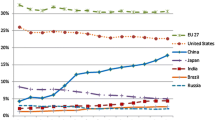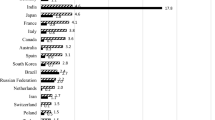Abstract
Investigating Iran’s scientific proficiency reflected in its scholarly outputs indexed in SCI during the 21st century and 1980s, the present study tries to propose the use of three features of science production including Specialty Diversity, Specialty Stability, and the growth of publications in the specialties, as the primary criteria in evaluating the contribution sustainability of a science system at macro level. They can be seen as the prerequisites every science system should realize to ensure a sustainable movement towards scientific development. The results reveal that Iran’s contributions had been not only limited in number in 1980s, but also exposed to serious subject fluctuations, so that a scarce number of the fields were found to be stable regarding Iranian contributions. Moreover, none of them had experienced a significant, exponential positive growth during the decade. The situation is incomparable to the 21st century where Iran’s contributions were as diversified as almost all of the SCI subject categories. It also reached long- or short-term stability in a majority of the categories. None of the previously stabilized specialties collapsed in the second 6-year sub-period. On the other hand, previously fluctuating fields mostly stabilized later. Moreover, a majority of the fields experienced significant exponential growths. Overall, according to the results, a developing science system might be characterized by its Specialty Diversity and Stability, as well as an annual growth in its publications in the specialties. Though meeting the criteria does not necessarily guarantee the achievement of quality standards, it may enhance the visibility of the contributions and thereby their recognition.


Similar content being viewed by others
References
Amin, M., and Mabe, M. (2000). Impact factors: use and abuse. Perspective in publishing, No. 1.
Baradar, R., Tajdaran, M., Musavi, M., & Abedi, H. (2009). Mapping the Iranian ISI papers on nanoscience and nanotechnology: A citation analysis approach. Malaysian Journal of Library & Information Science, 14(3), 95–107.
Davari Ardakani. (2007). The illusion of development by increasing the amount of papers in ISI. Iran [in Persian]. http://www.iraninstitute.com/1386/860521/html/think.htm. 12 Aug 2007. Accessed 26 July 2008.
Ghaleh, N. R., Siadat, F., & Azizi, F. (2004). Quantitative and qualitative assessment of biomedical publications from Iran, Pakistan and Egypt through their impact factor. Journal of Pakistan Medical Association, 54(10), 528–529.
Glänzel, W., & Schubert, A. (2003). A new classification scheme of science fields and subfields designed for scientometric evaluation purposes. Scientometrics, 56(3), 357–367.
Hayati, Z., & Ebrahimi, S. (2009). Correlation between quality and quantity in scientific production (A case study of Iranian organizations from 1997 to 2006). Scientometrics, 80(3), 625–636.
Jokar, A., and Ebrahimi, S. (2007). Nations tendency towards citing Iranian scientific outputs. Majjale-ye Ketabdari va Ettela’ Resani. The journal of library and information Science (In Persian), 10 (4). http://www.aqlibrary.ir./Issue/ShowOneArticle.aspx?Articlecode=478. Accessed 8 July 2008.
Katz, J. S. (1999). The self-similar science system. Research Policy, 28, 501–517.
Katz, J. S. (2000). Scale-independent indicators and research evaluation, Science and Public Policy, 24(1): 23–36(14). http://www.sussex.ac.uk/spru/jskatz Accessed 3 July 2004.
Katz, J. S., and Hicks, D. (1995). The Classification of Interdisciplinary Journals: A New Approach Proceeding of The Fifth Biennial Conference of The International Society for Scientometrics and Informatics, Rosary College, River Forest, Il, USA, June 7–10, 1995. www.sussex.ac.uk/Users/sylvank/pubs/ClassInterdiscJournals.pdf. Accessed 5 Sept 2004.
Malekzadeh, R., Mokri, A., & Azarmina, P. (2001). Medical science and research in Iran. Archives of Iranian Medicine, 4(1), 27–39.
Mehrdad, M., Heydari, A., Sarbolouki, M. N., & Etemad, S. (2004). The basic science in Islamic Republic of Iran. Scientometrics, 61(1), 79–88.
Moed, H. F. (2005). Citation analysis in research evaluation. Dordrecht: Springer.
Moin, M., Mahmoudi, M., & Rezaei, N. (2005). Scientific output of Iran at the threshold of the 21st century. Scientometrics, 62(2), 239–248.
Moosavi, F. (2003). The study of the possibility of ascending of Iran to top ten science producing countries of the world. Rahyaft (in Persian), 30, 79–89.
Noroozi Chakoli, A., Hassanzadeh, M., Nourmohammadi, H. (2008). Evaluation of Iran scientific productions based on ISI statistics through 2006–2007. In H. Kretschmer & F. Havemann (Eds.), Proceedings of WIS, Berlin Fourth International Conference on Webometrics, Informetrics and Scientometrics & Ninth COLLNET Meeting Humboldt-Universität zu Berlin, Institute for Library and Information Science (IBI). Available at http://www.collnet.de/Berlin-2008/NoroozichakoliWIS2008eis.pdf.
Noroozi Chakoli, A., Hassanzadeh, M., Nourmohammadi, H. (2010). Scientific products of Iran in ISI from 1993 through 2007. International Journal of Information Science and Management, 8(2), 11–27.
Ogden, T.L., and Bartley, D.L. (2008). The ups and downs of journal impact factors. Annals of Occupational Hygiene, 52(2), 73–82. http://annhyg.oxfordjournals.org/cgi/reprint/52/2/73. Accessed 10 July 2010.
Ortner, H. M. (2010). The impact factor and other performance measures—much used with little knowledge about. International Journal of Refractory Metals and Hard Materials. (in Press).
Osareh, F., & Wilson, C. S. (2000). A comparison of Iranian scientific publications in the Science Citation Index: 1985–1989 and 1990–1994. Scientometrics, 48(3), 427–442.
Osareh, F., & Wilson, C. S. (2002). Collaboration in Iranian scientific publications. Libri, 52, 88–98.
Price, D. J. de Solla (1963). Little science. New York: Columbia Press.
Seglen, P.O. (1997). Why the impact factor of journals should not be used for evaluating research. British Medical Journal, (314), 498–502. http://bmj.bmjjournals.com/cgi/content/full/314/7079/497. Accessed 12 April 2005.
Sotudeh, H. (2010). Are Iranian scientists recognized as their productivity enhances? A comparison of Iran’s impact to global norms in different subject categories of Science Citation Index during 2002–2005. Scientometrics, 83(1), 39–54.
Sotudeh, H. (2011). Concentration effect of citation to Iranian papers: Iran Matthew Core Journals. Online Information Review, 35(3), 471–491.
Sotudeh, H., Changiz, F.,and Hashemnia N. (2008). Iranian scientists’ approach to publishing in and referencing to Open Access journals. Presented at the First Conference on Medical Scientometrics, Isfahan Medical University, 5–6th March 2008, Isfahan, Iran.
Yalpani, M., and Heydari, A (2006). A critical study of research status in Iran: the case of scientific profiles of 10 highly productive Iranian chemists. Korsi News 2006 [in Persian]. http://www.korsi.ir/statics/Dr.%20Heidari%20Article.doc. Accessed 26 July 2008.
Author information
Authors and Affiliations
Corresponding author
Electronic supplementary material
Below is the link to the electronic supplementary material.
Rights and permissions
About this article
Cite this article
Sotudeh, H. How sustainable a scientifically developing country could be in its specialties? The case of Iran’s publications in SCI in the 21st century compared to 1980s. Scientometrics 91, 231–243 (2012). https://doi.org/10.1007/s11192-011-0542-3
Received:
Published:
Issue Date:
DOI: https://doi.org/10.1007/s11192-011-0542-3




